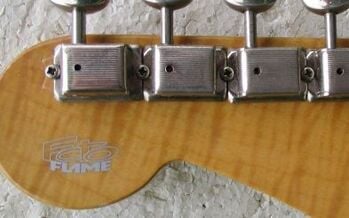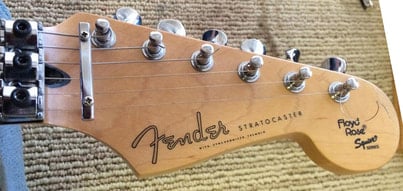FOTO FLAME FINISHES
|
In the late ‘80s and ‘90s new Foto Flame (and not Photo Flame, as sometimes reported!) finishes were available for Japanese Fender Stratocasters. They represented an attempt from Fender to compete with the extremely figured maple tops that were increasingly fashionable since the 1980s.
Despite many legends, Fender had nothing to do with the development of the foto flame process, and no film company, such as Kodak or Fujifilm, or Polaroid, was involved because this finish was not a photo! The only thing Fender did was choose the name foto flame, for marketing purposes. This effect indeed had been developed and patented by Fujigen, which played Fender and Ibanez against each other to get both to order foto flame instruments and make the project a success and their investment worthwhile. The foto flame image (and quilt image used by Ibanez, called "gravure") was created digitally and printed on a special heat-activated plastic film with something you can refer to as special ink. A piece of this plastic film with the printed image was laid on top of a body which was placed in a very expensive heated vacuum press. Everything was vacuumed and heated. |
After the correct amount of time, the press was opened up and the film was removed and thrown away. The only thing that remained was the microns-thick "ink" print of the flame figure transferred to the body. After that, it was clear coated as normal. The result was impressive, and it was not always easy to distinguish a foto flame guitar from an instrument with a figured maple top.
It's interesting that Fujigen also was a subcontractor for the auto industry, making the wood panels inside Lexus and Toyota cars (again cars!) so this process had multiple application potential as well.
It's interesting that Fujigen also was a subcontractor for the auto industry, making the wood panels inside Lexus and Toyota cars (again cars!) so this process had multiple application potential as well.
Fender Foto Flame STRATOCASTER
|
There is a lot of confusion around the foto flame Stratocasters because Fender didn’t manufacture only a model with this finish, but many different models.
The first Stratocaster available with a foto flame body realized for the Western market was the 1989 US Contemporary Stratocaster, made in Japan and assembled in the USA, joined, in 1992, by Collectable and HRR Stratocasters (see previous chapter). |
|
Between 1994 and 1996, Fender Japan also made another foto flame export model, called Foto Flame Stratocaster, which was a ’60s style reissue with rosewood fretboard, vintage tremolo, three single coils, and an alder body with basswood top. Foto flame effect was imprinted both on the top of the body (but not on the back) and on the neck. It could be recognized by the Foto Flame Logo on the back of the headstock.
|
The foto flame Stratocaster should not be confused with the 50’s and 60’s Collectable Stratocasters with the foto flame finish. In fact, these reissue models had a basswood body, and the foto flame finish was applied also on the back of the body, but not on the neck.
A locking tremolo version of the Foto Flame strat, the Floyd Rose Standard Stratocaster Foto Flame, made between 1992 and 1996, was devoid of the Foto Flame logo on the back of the headstock and the foto flame effect was imprinted both on the top and on the back of the body, but not on the neck. It is often confused with the HRR Stratocasters, but it can be distinguished from them because it featured 21 frets, only two knobs (volume and tone), a rectangular neck plate (not asymmetric like the HRR models), the "Floyd Rose Squier Series" logo on the headstock and the Floyd Rose II bridge.
|
Furthermore, Fender Japan also made a few models with the foto flame finish intended for the Japanese domestic market only. For example, the ST62-70NS, which had an alder body with a foto flame finished basswood cap, or the Anniversary Stratocasters ST54-70AS, ST57-65AS and ST62-65AS, which featured foto flame necks with the foto flame logo. Also, the Squier Silver Series SST-39 and a few Pro Feel Stratocasters (STR-130LS, STR-92LS) were available with a foto flame body.
|
foto flame finish cracks
Unfortunately, foto flame finishes experienced some problems over the years. Fujigen did extensive testing to check everything because this whole idea and process had never been done before and there was nothing to get any experience from previous work. But one thing they couldn't check was the time. Some foto finish guitar today shows some characteristic cracks on the finish, probably because there was something in the ink print material that was not completely compatible with the poly finish. Something that has taken years to show up. There is another problem as well: the beautiful blue sunburst color often turns a strange green color.
Antonio Calvosa













